Now that the Galaxy S21 FE is out the way, the Galaxy S22 range will likely be the next big Samsung phones , and we're expecting them very soon. Leading the series, the S22 Ultra is expected to pack some top specs, but it might disappoint in one key area.
This area is charging speeds. Popular leaker Roland Quandt posted on Twitter to share that the Samsung Galaxy S22 Ultra will apparently get 45W charging. That's a speed we saw in the Galaxy S20 Ultra , but most other mobiles from the company, including the Galaxy S21 Ultra , just use 25W.
Quandt even showed an image of the packaging for a 45W wall charger - remember, Samsung doesn't include powering blocks in all its flagship phones anymore, to reduce e-waste and help the environment.
According to a new price leak , the Samsung Galaxy S22 Ultra is expected to start at €1,300 for 8GB of RAM and 128GB of storage - that converts to about $1,470, £1,090 or AU$2,050, so it's an expensive phone.
So if the phone is so expensive, why is the charging speed so slow?
Analysis: 45W isn't fast enough for an 'ultra' phone
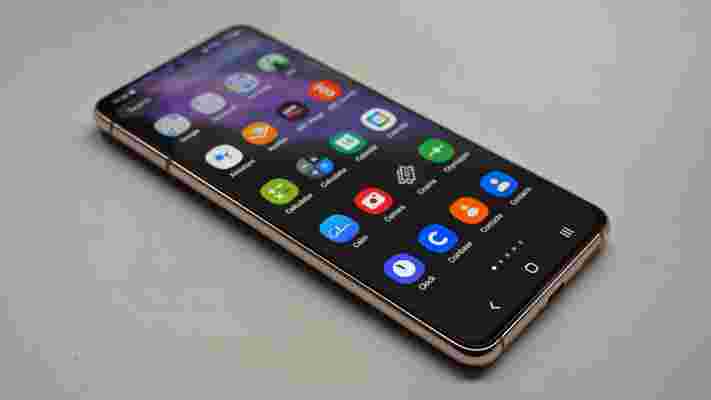
Most top-end phones get fast charging speeds. We already know the OnePlus 10 Pro will get 80W powering and the Xiaomi 12 Pro will get 120W, and both phones are expected to be top rivals to Samsung's new series of phones.
Judging by precedent, other top-spec rivals from companies like Oppo, Realme and Honor will also use charging speeds of at least 65W, but likely up to or even beyond 100W.
The difference isn't just in minutes - while a 25W phone can take about an hour and a half or two hours to power to full, when we tested 120W in the Xiaomi 11T Pro , it took just 20 minutes to fully charge.
So fast charging is a useful feature, especially for people who make the most of it (many of us forget to charge our phones until the last minute). And it's curious that Samsung still doesn't offer quick powering, especially on a phone that's meant to be an 'Ultra' device.
In Samsung's defense, fast charging leads to increased battery depreciation, which means the battery life can get worse over time - that's especially the case if you overcharge a mobile by leaving it plugged in when it's at 100%, and that's very easy to do when a device powers up so quickly.
But there are solutions to these issues - Sony phones have a great smart charging feature for example, which lets you set a time for your phone to be fully powered and the device will slowly charge until then. This would be a great alternative to quick charging if you've got time on your side.
That is to say, though there are issues with fast charging phones, there are also solutions to work around them. Samsung's decision to stick to 45W charging isn't so easy to excuse.
Wearables of CES 2022: new smartwatches from Fossil, Razer and Garmin
Much of CES 2022 has been held virtually this year rather than in-person, but we've still seen a whole host of fantastic hardware get unveiled. In this article, we're going to be rounding up the best devices in the wearables category.
You've got more choice than ever when it comes to picking the best smartwatch for your wrist, and these new models for 2022 give the current devices some serious competition – both in terms of cutting-edge smartwatches and hybrid watches that retain more of a classic timepiece look.
These wearables also point towards the future of this device category, with watches, trackers and even smart rings getting smarter all the time, and featuring more and more on-board sensors to monitor your vital statistics.
1. Garmin Venu 2 Plus
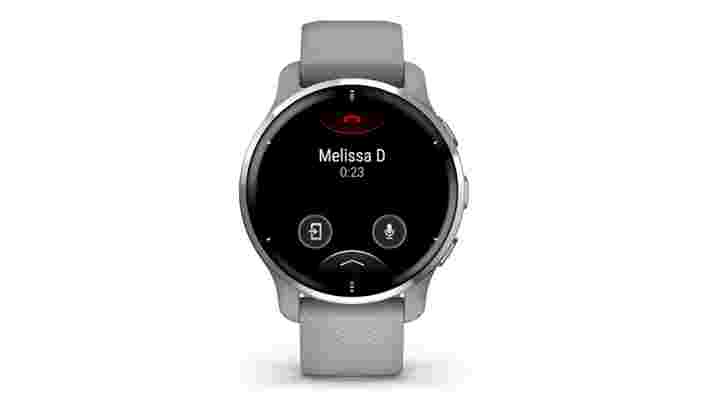
Garmin has carefully carved out a sizable niche for itself in the smartwatch market, and that niche is about to get bigger with the arrival of the Garmin Venu 2 Plus – the follow-up to the existing Garmin Venu 2 , which has already impressed us.
The big difference between the existing and the new model is voice control: you'll be able to use your phone's digital assistant (Siri, Google Assistant or Bixby) and take calls from your wrist, so this updated smartwatch will allow you to keep your smartphone in your pocket or bag for longer. Other than that, this is very much the same as the Venu 2 that we've already seen, with 24/7 heart rate tracking, on-board GPS, SpO2 measurements, all-day stress tracking, sleep monitoring, and women's health tools.
You can pick this up direct from Garmin for $449.99 / £399 (we're still waiting on the official price in Australia). That's quite a bit more than the Venu 2, but for what you get in this wearable package, you might well consider the investment worth it. Your color combination choices are black and slate, cream-gold and ivory, or powder gray and silver.
2. Razer x Fossil Gen 6
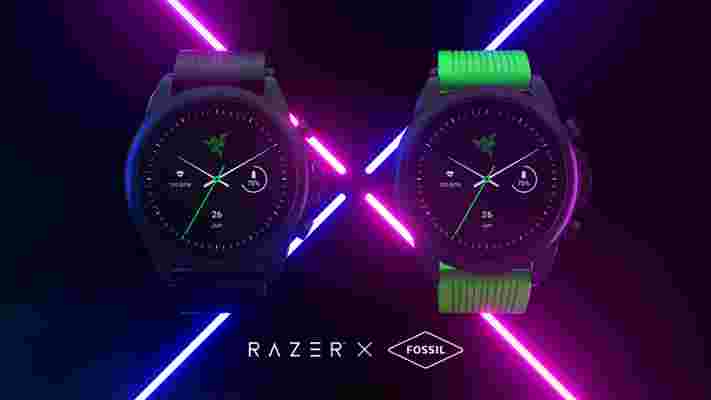
When it comes to Wear OS smartwatches, Fossil is one of the best in the business – and the flagship Fossil Gen 6 timepiece now has a new edition, courtesy of Razer. You might struggle to get your hands on this one though, considering only 1,337 units are going to be produced in total.
The Razer x Fossil Gen 6 is one of the first smartwatches we've seen to be powered by the latest Snapdragon Wear 4100 Plus Platform - we also know it's going to be right up to date with software too, running the latest Wear OS 3. In addition to the usual health and fitness tracking, it also has watch faces supporting Razer's Chroma RGB lighting system.
You'll be able to get the Razer x Fossil Gen 6 around your wrist for $329 / £329 (around AU$450), if you're lucky enough to be able to get one. Strap options are black or bright green, and you can sign up now on the Razer website to get notified when this limited edition smartwatch goes on sale.
3. Garmin Vivomove Sport
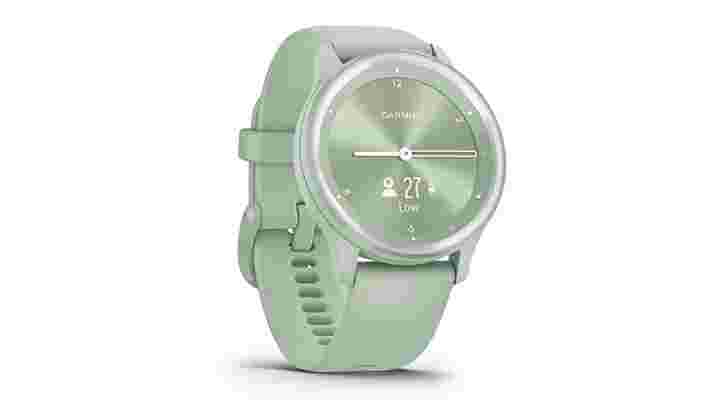
The Vivomove Sport is a hybrid watch, perfect for those who prefer their watches to be in the traditional analog form but don't mind a dash of smarts on top. In other words, it looks like a normal watch, but it's still counting your step count, your burned calories, and your other vital statistics in the background.
You can view these stats via a hidden digital display that slides into view alongside the analog hands when needed, and there's also the option to show phone notifications on the watch face too. Garmin says battery life is up to five days, and one of the advantages of not having a fully digital display is more time between battery charges.
This isn't the first hybrid watch that Garmin has released of course – the Vivomove Sport is actually very similar to the Garmin Vivomove 3 , though it's slightly cheaper: you can pick up the new Sport model from Garmin for $179.99 / £159 / AU$279, and it's available now in Cool Mint, Black or Cocoa.
4. Skagen Falster Gen 6
We've previously been impressed with the Skagen brand of smartwatches released by Fossil, and the Skagen Falster Gen 6 is very similar to the Razer x Fossil Gen 6 that we've mentioned above – it has the same Snapdragon Wear 4100 Plus processor, and will get the same Wear OS 3 software update when the time comes.
The differences are mainly aesthetic – you can see that the Skagen Falster Gen 6 has a more classic smartwatch look – and it's available in a total of six different models, with various case colorings and strap types covered (stainless steel mesh and brown leather straps are two of the options in the range).
There are plenty of health and fitness tracking features here, as you would expect, and the sensors extend to a blood oxygen (Sp02) sensor on the back. In terms of pricing, you can pick up the Skagen Falster Gen 6 for $295 / £279 (which is roughly AU$410).
5. Movano Smart Ring
Smart rings are notoriously difficult to get right, but new startup Movano isn't deterred: it's bringing out a new smart ring later this year. We're not sure how much it'll cost yet, but the company has said it's aiming for a price point under $299 (about £230 / AU$420).
The ring has an impressive list of capabilities, covering sleep monitoring, heart rate, heart rate variability, respiration levels, temperature, blood oxygen readings, step count, and calories burned – and the company is promising that the device is going to get more features over time as well.
Those features, pending regulatory approval, will include blood glucose and blood pressure monitoring, something that smart rings haven't managed to achieve so far. The Movano device might just hit the sweet spot in terms of price and features.
6 reasons why you should change your VPN protocol
It's one of the most common VPN troubleshooting tips. If your connection seems slow, change your VPN protocol . And it's true: choose your protocol wisely, and it might double your speeds, sometimes more.
But there's so much more to it than performance. Changing your protocol can bring all kinds of benefits, improve your VPN experience, get app features working better, and other VPN functionality you didn't even know existed.
And it's all so easy to do. Point, click, or a couple of taps, and you're done. Here we'll explain just some of the reasons a quick protocol change could improve your VPN life.
1. Your VPN connection is slow
VPN speed varies greatly depending on protocol, so it's a good idea to check that you're using the fastest option.
Many VPN apps have an 'automatic' protocol setting which claims to select the best protocol for you, but if your speeds are still slow, it's worth turning this off and choosing something manually.
If your VPN provider has a custom protocol of its own - Lightway for ExpressVPN , NordLynx with NordVPN , Catapult Hydra for Hotspot Shield - then that normally delivers the fastest VPN results.
Try WireGuard after that, then OpenVPN, IKEv2 or L2TP.
If your VPN supports PPTP, that might be fast, but beware: it's also so insecure that most providers have dropped it. Only use it when you've absolutely no need for security (you're unblocking Netflix rather than protecting online banking sessions, for example).
Keep in mind that although this order is generally correct, sometimes changing it might help. If your VPN provider has just messed up some WireGuard update, say, then switching to OpenVPN might be faster, at least until the fix is in. Try all the main options, see which works for you.

2. You can't connect to the VPN server
If you're in a country which is more interested in censorship than internet freedom, VPN connections may be connected and blocked - it's one of the reasons why VPNs for China , UAE and Russia have become such popular tools.
Some VPN-unfriendly networks use similar trickery. The end result: you hit Connect, but your app hangs at the 'Connecting...' stage and it's never ready for use.
Changing your protocol might help you avoid detection and get connected. If your VPN has a protocol specifically designed to bypass VPN blocks - VyprVPN's Chameleon, say - then try that first. But there are no fixed rules here, so if they don't work, try the others, too.
Look for protocol-specific settings that may help. Choose OpenVPN in some VPN apps and you'll get a setting called something like 'Obfuscation', for instance. Checking that box adds a stealthy extra layer to your traffic, in theory making it harder to detect.
You might see related options, including the ability to set a port, but these work very differently depending on the provider. Check the support site for specific advice.
3. Connecting to VPN servers takes a long time
Choosing a VPN protocol doesn't just affect the connection speed and security. It also changes the rules on how the connection is established; the steps your app has to go through to communicate with the VPN server and get your connection up and ready for use.
Selecting the right protocol can make a huge difference. We've seen WireGuard and IKEv2 connections up and running in under two seconds. Standard OpenVPN connections might easily take 10-20 seconds. When apps don't get this right, or a service is having problems, connections might take 40 seconds or more to set up.
If you're unhappy with your VPN connection times, then, just try the other protocols, see which comes out on top.
Keep in mind that the results can vary by platform, too, so don't assume that what works well with your Windows VPN is also a smart choice for your iPhone VPN app . Try a couple of connections with every protocol available before you decide.
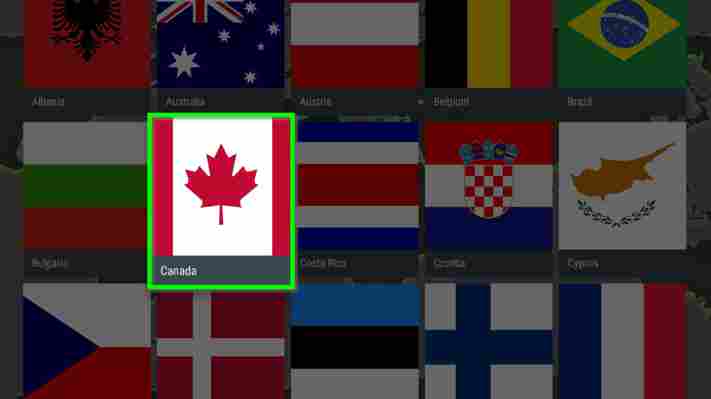
4. Your app doesn't list a supported country
Imagine that you need a VPN which offers countries that aren't well supported elsewhere, perhaps in South America. You find one, sign up, install and launch the app, and: some or all of the countries you need, are not on the list. What's going on?
VPN servers don't always support every protocol offered by the service. If your provider defaults to WireGuard, for instance, then its apps will show you countries where there are WireGuard servers. If the country you need only has OpenVPN servers, it won't appear on the list.
The results can be dramatic. Choose 'Americas' in ExpressVPN's Windows app, for instance, and it normally offers you 16 countries. If you're using the L2TP protocol, you'll only see three. There are good reasons for this - L2TP is a Windows-only protocol, it's not recommended for speed or security, so the company only supports it in a bare minimum of locations - but it might still surprise you, if you don't know what's going on.
If your location list doesn't have everything your provider promises on its website, then, changing protocols might help. And if it doesn't, contact support to get an explanation of why the website is offering something that apparently doesn't exist, and if there's not a very good answer, ask for your money back - that's what VPN free trials are there for!
5. Your VPN connection keeps dropping
Maintaining your VPN connection takes time and effort with some protocols, but almost nothing at all with others. If you don't choose the best option, or your app isn't well implemented, or your provider's servers are overloaded, it's possible you'll see regular connection drops.
If this is a common problem for you, try another protocol. More modern options are usually the most reliable - WireGuard, ExpressVPN's Lightway, NordVPN's NordLynx - so try those, first. But don't rule anything out. WireGuard is a reliable protocol in theory, but if an app isn't setting it up properly (or there's just some bug in the latest app version), it might be useless. Try every option, just to be sure.
Some apps allow you to choose a protocol, but then also give you the option to connect using UDP or TCP . Normally this defaults to UDP for the best performance, but switching to TCP should improve reliability, at the expense of some speed.
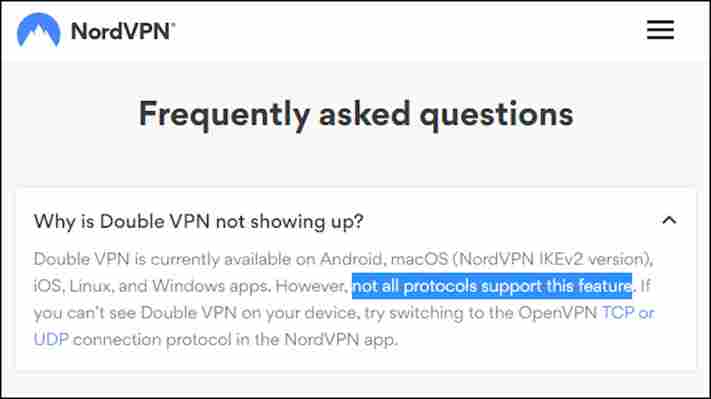
6. VPN feature doesn't work or isn't visible
Some VPN apps offer very lengthy lists of clever technical features, as they try to win over new customers. That's good news for the user, in theory, but there could be a problem. Some features rely on you choosing specific protocols, and if you switch to something else, they may not work as well, or the app might not allow you to use them at all.
Sign up for NordVPN , for instance, and you might want to try its Double VPN feature. This encrypts your traffic once, routes it to one VPN server, encrypts it a second time and re-routes it through another VPN server for the maximum possible security.
Sounds great, so you install the app on your Windows laptop, browse the menus, but can't find any mention of Double VPN.
The problem? Double VPN isn't supported by all protocols, not even NordVPN's own NordLynx. You'll have to switch to OpenVPN UDP or TCP before it shows up.
We suspect most users would never guess Double VPN's availability depends entirely on their choice of protocol, but it's a perfect example of this problem. If you're having any kind of odd problem with a VPN app , try switching protocols, just as a last resort: who knows, it just might be the answer you need.